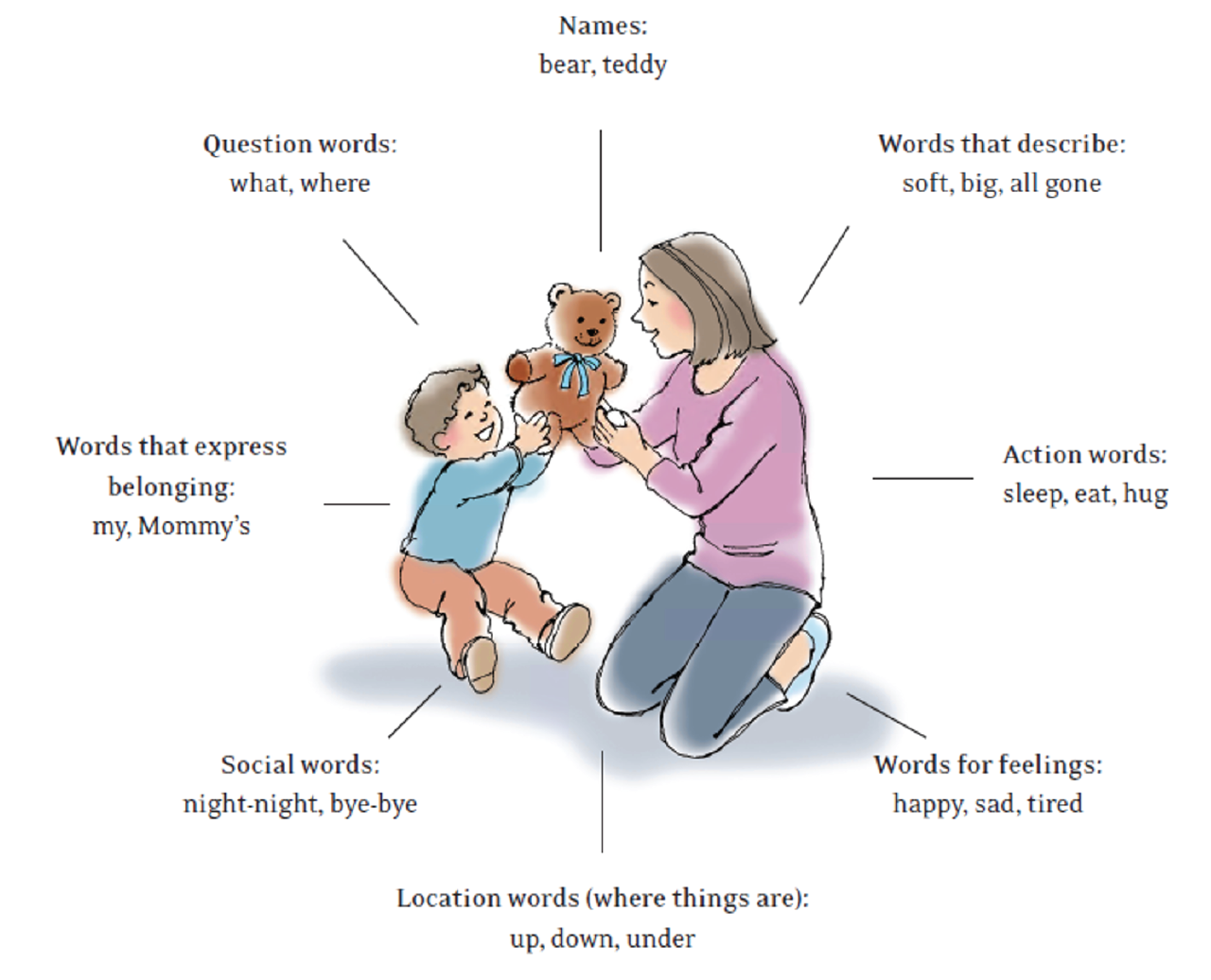Tips to Build Vocabulary: Repeat Words That Match Your Child’s Interests

All parents look forward to the day when their child says his first word. If your child is not yet using words, you might be wondering what you can do to help him.
There’s a lot you can do! One great way to build your child’s vocabulary is to repeat words that match his interests as you interact throughout the day. It’s most helpful to repeat a word in more than one situation. When you repeat a word many times in different situations, you give your child lots of opportunities to understand the word and eventually use it on his own!
Which Words Should You Repeat?
The words you repeat should be ones that are related to what your child is communicating about and interested in at that moment. When you observe and listen closely, you will get a better idea of what he is interested in. For example, if he is playing with cars by making them go down a ramp, the words “the car is going down” would relate to his interests. If he enjoys being chased and he wants you to chase him, you could repeat, “I’m gonna get you!” as you chase him. Then, when you catch him, you say, “Got you!”. Think about whether the words you repeat capture what your child is trying to communicate or is motivated to communicate. Words like "please" and "thank you" can be important to adults, but they are not likely to be words your child is motivated to say.
Words like “please” and “thank you” can be important to adults, but they are not likely to be words your child is motivated to say.
Consider repeating words that your child understands and communicates about through actions or gestures but can’t yet say. For example, your child might often raise his arms to be picked up but doesn’t yet say “up”. In this case, you could repeat the word “up” each time he asks to be picked up.
Repeat words that can be used in a variety of situations. For example, the word “up” can be used not only when picking your child up when he’s in his crib or when he wants to climb into your lap, but also when he goes up the stairs. When you choose a word that can be used in many situations, you will be able to repeat it more often. This gives your child even more opportunities to learn that word.
There are many types of words
When repeating words for your child, it is important to include a variety of word types. It’s natural to tell your child the names of things and important people in his life, like “apple”, “ball” or “Grandma,” but your child also needs to learn other kinds of words.
In addition to names, children need to hear action words (“go”, “jump”), words that describe things (“big”, “fast”), location words (“in”, “under”), greeting words (“bye bye”) and feeling words (“happy”, “tired”). Look at all the words you can use to talk to your child about a teddy bear, depending on what he’s interested in:

(Weitzman, 2017, p. 89)
If your child is hugging his bear, you could use the word “hug” (an action word) and say, “You’re hugging the bear!”. You could also use the word “soft” to describe how the bear feels as your child hugs him (say, “He’s so soft”, as you stroke the bear). If your child enjoys pretend play, like putting his bear to bed, you could repeat the words “good night bear” (a social word) or say, “the bear’s going to sleep” (an action word) as your child puts him to bed.
Why Repeating a Variety of Word Types is Important
We know that it's important for children to hear lots of language during back-and-forth interactions to help them develop their own vocabulary. However, research has shown that what is most important is not just the number of words children hear, but the number of different words they hear.
Research has shown that what is most important is not just the number of words children hear, but the number of different words they hear.
When you observe your child’s interests, think about what he would want to talk about if he could – you’ll see that he is interested in much more than the names of things! He might be interested in how fast a truck goes by, or how loud the horn is. He might want to run or jump into a puddle. He might want to show you that a page in his touch-and-feel book is rough or soft.
When you talk with your child and use many different kinds of words, you give him the building blocks to put words together when he is ready. By repeating words from the different categories shown in the teddy bear image above, you are providing your child with tools he can later use to communicate many different things, like “big drink”, “Daddy come” or “go fast”.
How to Repeat a Word
Once you’ve observed your child and identified a word that matches his interest, the next step is to repeat it during fun, back-and-forth interactions. Do this naturally on and off during the interaction as it matches what he’s doing or communicating – not all at once.
Repeat the word by:
- saying it in a short, grammatical sentence.
- stressing the word – e.g. “The car went down!”
- slowing down as you speak so your child can pick out the word more easily.
- using an action or gesture as you say the word to demonstrate what the word means.
For example, if your child is interested in pushing his toy car down the car ramp, he’s likely to be interested in the action the car is doing. So when he pushes his car down the car ramp, repeat the word in a short sentence, like “Wheeee! The car went down!” Emphasize the word “down” and slow your speech to give your child the opportunity to hear it. Show the meaning of the word by adding an action or gesture, like moving your arm down quickly as you say “down!”
Remember, there should never be any pressure for your child to say the word after you – he will try to say it when he’s ready!
To Recap…
As a parent, you play the biggest role in building your child’s vocabulary. Repeating words naturally during your interactions and making sure those words capture what he’s focused on and interested in will help him express what’s on his mind when he is ready.
These tips are from It Takes Two to Talk® – The Hanen Program® for Parents of Children with Language Delays and from Target Word™ – The Hanen Program® for Parents of Children who Are Late Talkers. You can read more about these tips, and many others, in the It Takes Two to Talk® guidebook.
